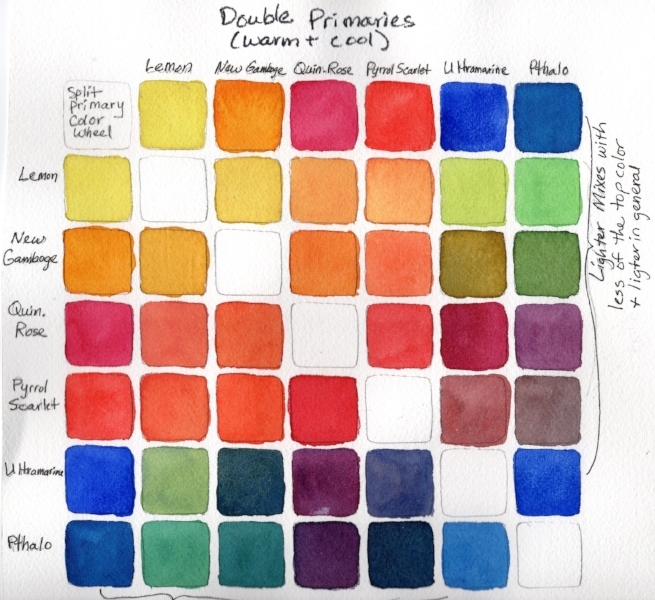The following list of beginning and basic watercolor supplies is what I give to my beginning students and as a basic list for some of my classes. Sometimes I add to or subtract some supplies depending on the class or workshop. You can see a more in-depth talk about watercolor supplies on my Youtube channel - Lorraine Watry or click this link for the first video: Watercolor Supplies Part 1 of 4
The one thing that I do recommend to all of my students is that they buy artist or professional grade watercolor paint and paper because it really makes a difference when working with watercolor. It may seem like they could save some money when buying watercolor supplies by buying the student grade paint and paper, but because these student grade supplies don’t work the same the students end up getting frustrated.
Click to enlarge
The student paper is often made of wood pulp and can’t handle the same techniques. This paper also dries a lot faster and that will cause streaking and blooms to happen more readily. The student grade paper often tears when using masking tape or masking fluid to protect areas until we are ready to paint them.
Click to enlarge
Student grade paints are another problem. Students will often buy the cheaper, student grade pigments. However, these paints include a chalky filler to extend the pigment in the mix and make them less expensive. The chalky filler will make these paints less vibrant and more opaque compared to professional watercolor. Students may have paid less for the student grade paint, but they tend to use more of it because they are trying to get the same intensity as I get with my professional paint.
Watercolor paint is unlike acrylic and oil paint because it can dry out and be re-wet. You don’t throw it out like you do with acrylic or oil after they have hardened. So, it takes a long time to go through a tube of professional or artist grade watercolor.
The brushes are the third basic watercolor supply that can make a difference in how easily it is to learn and work with watercolor. The most important thing is to get brushes made for watercolor not acrylic or oil brushes. There are better and better synthetic watercolor brushes, three brands that are decent are Princeton Neptune, Golden Fleece by Cheap Joes, and Grey Matters by Jack Richeson. My current favorite brushes that cost a little more than synthetic brushes are a brand called Silver - Black velvet. These brushes are a blend brush made with half synthetic bristles and half natural hair.
Main Supplies:
Watercolor Paper:
1 or 2 sheets (22x30) of 140 lb., cold press, Arches or Fabriano watercolor paper or a watercolor paper block (a block is a bound tablet of paper, 10”x14” would be fine)
Click to Enlarge
Watercolor Brushes:
At least two round watercolor brushes that come to a good point - a size #16 or larger and around a #6 to #8 (If you have other brushes, please bring them. My current favorite brushes are a #16 or #20 blend (½ synthetic/½ natural) - Silver Black Velvet brushes (a little more expensive), or a #8, Quill by Princeton Neptune (less expensive). A small flat #2 or #4 brush is good to have, too.
Watercolor Paint:
If you can only afford 3 or 4 tubes, please get Ultramarine Blue or Cobalt Blue, Quinacridone Rose, Aureolin (Cobalt Yellow), and Burnt Sienna. I found a set of Daniel Smith colors on Amazon that works great plus a small tube (5ml) of Burnt Sienna. If you have time to order it and have it shipped before the class, the set is 6, 5ml tubes: Daniel Smith Extra Fine Essentials Introductory watercolor If you already have paint or can purchase others, these are good to have: Cobalt Blue, Cadmium Red or Pyrrol Scarlet, Lemon Yellow or Hansa Yellow Light, New Gamboge, Quinacridone Gold, Sap Green, Quinacridone Magenta, Manganese Blue or Cerulean Blue (I use mainly Daniel Smith paint, but also Holbein, Daler Rowney, and Winsor & Newton)
Other Supplies:
Click to enlarge
Click to Enlarge
A board to tape or staple your paper to, don’t need if buying a watercolor block. I use Gatorboard or gatorfoam - 1st (foam core with a hard surface) or a white, corrugated plastic sign (for garage sales from Home Depot or Art store might carry this) - 2nd
Something to lean your board on, that is about 2 1/2" to 3" high. (Some students have used a tuna fish can, flattened roll of paper towels, piece of styrofoam etc.)
Palette or white plastic plate 8” or larger (A good starter option - Creative Mark Folding plastic Palette ($4-$7) http://www.jerrysartarama.com/folding-plastic-palette)
Masking tape (I use the High Adhesion masking tape by Scotch from Home Depot's paint department. It says 'High Adhesion' inside of the roll and Pro Painter on the box, I think.) (See Image Below)
Removable Masking fluid or frisket (make sure it doesn’t say ‘permanent’. I use the Windsor and Newton, colourless art masking fluid.) Do Not shake masking fluid! (See Image Below)
Paper towels (I use Viva brand, extra absorbent and hold up well and NO texture)
TWO water containers (plastic or glass, should be about 5” or 6” high and around a 3” opening)
Spray bottle (bottle that you can adjust the spray to get bigger drops of water, not mist)
Pencil #2 and white or kneaded eraser
Sketch book (5”x7” or bigger, can be one you already have used)
Click to enlarge
If you have time you can order your supplies by mail, some good online art supply stores in the United States are: (I compare prices to get lowest)
Cheap Joes - www.cheapjoes.com
Jerry’s Artarama - www.jerrysartarama.com
Dick Blick - www.dickblick.com
or Amazon.com (has some supplies)
Click to Enlarge

